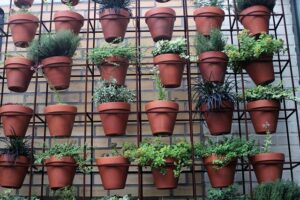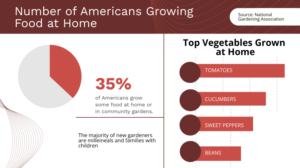Introduction
I can’t wait to pluck fresh, crisp vegetables from my own small oasis – even though you may only have a small area! It might sound too good to be true, but I’m amazed by the possibilities. I’ve learned that 35% of all households in America are now growing food at home or in a community garden. That’s a 200% increase in the last decade! As a curious newbie, I’m excited to join this growing trend of urban gardening. In this guide, I’ll explore 15 small space vegetables that not only survive but thrive in small urban spaces . From compact tomato varieties to vertical-growing greens, I’ve got your small-space veggie needs covered. Be ready to turn your urban nook into a productive mini-farm!
Cherry Tomatoes: My Urban Gardening Delight
I love cherry tomatoes for small spaces because they thrive in confined areas. Their compact size and high yield make them perfect for my container garden. You don’t need a large garden to enjoy these juicy, flavorful fruits.
For containers, I’ve chosen varieties like ‘Tiny Tim,’ ‘Micro Tom,’ and ‘Balcony.’ These types are bred specifically for container growth, and I’m impressed by how much fruit they produce relative to their size. I grow them in my raised beds also.
If you are limited on direct sunlight, you can use grow lights to supplement their needs. I also ensure my containers have good drainage and use high-quality potting soil.
Leafy Greens: My Vertical Veggie Superstars
I’ve found that leafy greens like lettuce, spinach, and kale are excellent choices for a small urban garden. I’m growing varieties such as ‘Buttercrunch’ lettuce, ‘Baby Spinach,’ and ‘Dwarf Blue Curled’ kale in small containers and vertical planters.
To maximize my growing area, I use vertical gardening techniques like wall-mounted planters and tiered shelves. This method not only saves space but also makes harvesting easier for me.
I practice succession planting to ensure a continuous supply of fresh greens. I plant new seeds every few weeks so that I always have a crop ready to harvest.
Herbs: My Flavor-Packed Space Savers
I grow essential herbs like basil, mint, and parsley in small pots on my windowsill and balcony. They provide fresh flavors for my cooking and fit perfectly in my small urban space.
I’ve created a compact herb spiral garden, which is a great way for me to grow multiple herbs in a small area. This design maximizes space by stacking plants vertically, creating different microclimates for each herb.
I grow some herbs indoors for year-round access and others outdoors to benefit from natural sunlight and better airflow.

Bell Peppers: My Colorful Container Champions
I’ve chosen compact pepper varieties like ‘Mini Bell,’ ‘Jingle Bells,’ and ‘Redskin’ for my container garden. These compact plants produce vibrant and flavorful peppers in my small space.
For my pepper plants, I use well-draining soil and containers with at least 12 inches in diameter. I make sure to water and fertilize them regularly.
To increase my pepper yield, I hand-pollinate using a small brush to transfer pollen from one flower to another.
Bush Beans: My Low-Maintenance Urban Legumes
I prefer bush beans over pole beans for my small space because they’re more compact and don’t require support structures. They’re ideal for my container gardening and produce a bountiful harvest in my limited area.
I’m growing top-performing bush bean varieties like ‘Provider,’ ‘Topcrop,’ and ‘Contender.’ They’re disease-resistant and produce tender, flavorful beans.
In my urban garden, I companion plant bush beans with crops like carrots, cucumbers, and strawberries to optimize space and improve yield.
Radishes: My Quick and Easy Urban Crop
I love growing radishes in my small urban space because they’re quick-growing and I can harvest them in as little as 4 weeks. They require minimal space, and I use them for intercropping with other vegetables.
For my impatient gardening needs, I’ve chosen fast-growing radish varieties like ‘Cherry Belle,’ ‘French Breakfast,’ and ‘Easter Egg.’ They produce crisp, spicy radishes in a short time.
I intercrop my radishes with carrots, lettuce, and peas. This helps me maximize space and ensures I have a continuous harvest throughout the growing season.
Carrots: My Root Vegetables for Shallow Containers
For my urban container garden, I’ve selected short carrot varieties like ‘Parisian,’ ‘Thumbelina,’ and ‘Short ‘n Sweet.’ These short-rooted carrots grow well in my small spaces and produce sweet, crunchy roots.
I prepare my soil carefully for successful carrot growth, using loose, sandy soil that is free from rocks and debris. This allows their roots to grow straight and avoid deformation.
To maintain my urban carrot patches, I thin seedlings to about 2 inches apart to ensure proper growth. I water regularly and use mulch to maintain soil moisture and reduce weed competition.
Zucchini: My Compact Squash for Urban Plots
I’ve chosen space-saving zucchini varieties for my urban garden, including ‘Bush Baby,’ ‘Raven,’ and ‘Eight Ball.’ These compact types produce abundant fruit without sprawling vines, perfect for my limited space.
For my zucchini plants, I use large containers with at least 18 inches in diameter. I fill them with well-draining soil and water regularly to keep the soil consistently moist.
To deal with common zucchini pests in my urban setting, I use organic insecticides and fungicides to keep issues like squash bugs and powdery mildew under control.
Eggplants: My Exotic Additions to Small Gardens
I’ve added dwarf eggplant varieties to my urban garden, including ‘Patio Baby,’ ‘Fairy Tale,’ and ‘Little Fingers.’ These plants produce tender, flavorful fruits in a compact form that fits perfectly in my small containers.
To grow eggplants in my containers, I use well-draining soil, water regularly, and ensure they get at least 6 hours of sunlight daily. I also use mulch to retain soil moisture and keep the roots cool.
To ensure successful fruit set, I hand-pollinate my eggplants by gently shaking the flowers or using a small brush to transfer pollen from one flower to another.
Green Onions: My Urban Garden’s Staple
I’ve adopted a sustainable approach to growing green onions by regrowing them from kitchen scraps. I place the white root end in water, and within a few days, I see new green shoots.
For my green onions, I use small pots, window boxes, and even recycled containers. I make sure they have good drainage and place them in a sunny spot.
I use continuous harvesting techniques for my green onions and harvest by cutting the green tops, leaving the white base to regrow. This method gives me a continuous supply of fresh onions.
Peas: My Vertical Growers for Tight Spaces
I’ve chosen compact pea varieties suitable for my urban garden, including ‘Dwarf Grey Sugar,’ ‘Tom Thumb,’ and ‘Little Marvel.’ These types produce sweet, tender peas in my small space.
To support my pea plants in my limited space, I use trellises, netting, and bamboo stakes. Vertical growing saves me space and makes harvesting easier.
I plant my peas in early spring or fall, as they prefer cool weather. I use well-draining soil and ensure they receive regular watering.
Microgreens: My Nutrient-Dense Urban Superfoods
I love growing microgreens in my urban setting because they’re packed with nutrients and I can grow them indoors year-round. They require minimal space, and I can harvest them in as little as 2 weeks.
My top microgreen varieties are radish, broccoli, and sunflower. I find these types easy to grow and they offer a range of flavors.
For year-round microgreens, I use shallow trays and high-quality potting mix. I place them in a sunny spot or under grow lights, and mist regularly to keep the soil moist.
[Graphic: A simple bar chart showing the nutrient density of microgreens compared to mature vegetables]
Chard: My Colorful and Productive Urban Greens
I’ve found chard to be an excellent choice for my small urban garden. It’s versatile, colorful, and grows well in containers. Its vibrant stems and large leaves add visual appeal to my garden.
For healthy chard, I use deep containers with at least 12 inches in depth. I fill them with well-draining soil and water regularly to keep the soil moist.
To ensure continuous production, I harvest chard by cutting the outer leaves, leaving the inner leaves to continue growing. This method gives me a constant supply of fresh greens.
Dwarf Cucumbers: My Compact and Prolific Producers
For my urban garden, I’ve chosen space-saving cucumber varieties like ‘Spacemaster,’ ‘Bush Champion,’ and ‘Patio Snacker.’ These dwarf types thrive in my small spaces and produce crisp, flavorful cucumbers.
I use trellises and cages to support my cucumber plants. This vertical growing technique saves space and improves air circulation, reducing the risk of disease.
To ensure successful fruit set, I hand-pollinate my cucumber plants using a small brush to transfer pollen from male to female flowers.
Garlic: My Low-Maintenance Urban Alliums
I grow garlic in containers with well-draining soil. Both hardneck and softneck varieties do well in my small spaces.
I plant my garlic in the fall, placing cloves about 4-6 inches apart. I make sure they receive regular watering and use mulch to retain soil moisture.
When it’s time to harvest, I know my garlic is ready when the leaves begin to yellow and die back. I cure the bulbs by hanging them in a cool, dry place for a few weeks.
Conclusion
I’m thrilled to have discovered these 15 vegetables that prove you don’t need a sprawling backyard to enjoy fresh, homegrown produce! With these space-savvy crops, anyone can transformed a small urban nook into a thriving veggie paradise. I’ve learned that successful urban gardening is all about creativity, patience, and a willingness to learn.
So start your own mini urban farm today, your taste buds (and your wallet) will thank you! I’m considering joining a local urban gardening community to share tips, swap seeds, and celebrate our harvests. According to a recent study, 80% of urban gardeners report improved mental health and well-being from their gardening activities. I’m looking forward to experiencing these benefits myself!
Here’s to greener cities and fresher, more sustainable meals – all from your own tiny urban oasis! I can’t wait to see how my small garden grows and evolves over time. Who knows? Maybe next year, I’ll be writing about my successful harvest and sharing my own tips with fellow urban gardeners!

